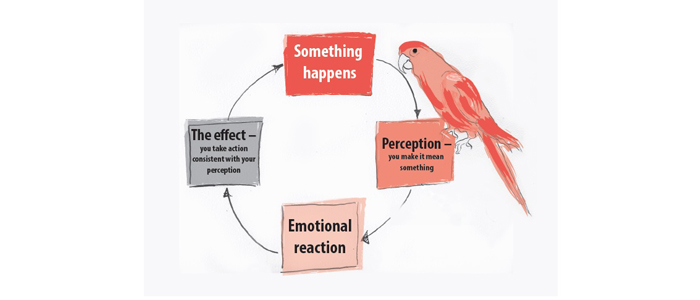Are you aware of your inner dialogue, that ‘parrot on your shoulder’? We give you the tools to assess your very own internal critic so you can think more clearly and make better, more informed decisions.
“People are always blaming their circumstances for what they are. I don’t believe in circumstances. The people who get on in this world are the people who get up and look for the circumstances they want, and if they can’t find them, make them.”
George Bernard Shaw
Once you’ve recognised your inner dialogue, your ‘parrot’, for what it is, you’ll start to notice it all the time. Sometimes, it says positive things to you: “Looking good today”, “I made a good job of that”, and so on. But very often, it says negative things and affects your behaviour and your mood without your being consciously aware of the process.
Often, the first thing you will notice is that you feel indefinably unconfident, or fearful, or angry, without knowing why, or when the feeling started. We all have different reactions to the different triggers in our lives, so the first thing to do is to notice that you are in a negative mood or state, and name the emotion.
There are four main categories your emotional state could fall into, and you can remember them by this simplified mnemonic: mad, bad, glad or scared. You may have your own choice of words for these emotions:
Mad: might be ‘angry’, irritated’, ‘livid’, ‘annoyed’ etc.
Bad: might be ‘depressed’, ‘down’, ‘guilty’, ‘ashamed’, ‘embarrassed’, and so on.
Glad: could be ‘happy’, ‘joyful’, ‘elated’, ‘proud’…
And scared: could be ‘terrified’, ‘anxious’, ‘worried’, ‘unsettled’ etc.
Find your own words for the emotion you are feeling, then:
Step 1: Identify the situation.
Describe the situation that triggered your negative mood. When did it start? What happened? What else was happening at the time? Be as specific as possible.
Step 2: Identify automatic thoughts – your parrot.
Make a list of all the automatic thoughts you had in response to the situation. This is the parrot on your shoulder, your inner dialogue, coming up with perceptions and trying to find meaning in the situation to explain your emotional reaction. Try to catch your own mind talking – what’s it saying?
Some of us blame others: “they’re out to get me”, “he’s a bully”, as a first reaction, but underlying this will always be an opinion about yourself – that’s what disempowers you. So we might say, “He’s a bully”, but most of us wouldn’t stop there and shrug it off – if we did, there would be no problem. We go on to beat ourselves up: “why can’t I come up with a quick response?”, “what’s wrong with me, that I feel so shaky when he starts in on me?”, “Why am I such a coward?”, “I’m useless”, “that’s typical of me”, “I’m such an idiot”, “I always mess things up”.
Step 3: Analyse your mood in detail – your emotional response.
Describe how you felt in the situation and how you’re feeling now. Examples might include: angry, upset, frustrated, scared, anxious, depressed, betrayed, disgusted or embarrassed.
Step 4: Describe the action you took.
Describe how a combination of your parrot and your emotions caused you to act in the situation: “I felt shaky and walked away”, “I got defensive and shouted at her”.
Now go back and challenge the conclusions you came to:
Step 5: Find objective supportive evidence.
Write down any evidence you can find that supports the automatic thoughts you listed in Step 2. For “I’m an idiot”, you might write down, “I messed up the presentation”, and “I missed the deadline and let the team down”. Come up with any and all thoughts you are having about the situation.
Step 6: Find objective contradictory evidence.
Now look rationally at your automatic thoughts and write down objective evidence that contradicts the thought. Consider other people’s perspectives as well – ask them, if necessary. Write down your new perspective. You might list successes you have had, good feedback you’ve received and people who respect and like you.
Step 7: Identify fair and balanced thoughts.
Look again at the thoughts you wrote down in Steps 5 & 6. Take a balanced view of the situation and write down your conclusions. So: “OK, I messed up this presentation, but I’ve learned a lot, and I know how to do it next time. I’ve never done it before, and in fact I’ve had compliments on my presentations in the past. My colleagues respect me, and some of them have made mistakes too. I just feel sympathy, I never decide they are idiots”.
Step 8: Monitor your present mood.
Take a moment to assess your mood now. Do you feel better about the situation? Is there any action you need to take? Note your present mood, along with the steps you need to take to feel better, to resolve the situation or maybe to put actions in place to make sure it never happens again.
Once you have done all this and taken time to digest this new way of looking at the situation, you will be able to think clearly, and make informed and sensible choices about what to do about it.
In the next blog post we’ll look at one of the things you might choose to do, which is to give someone some feedback.
This article is adapted from a chapter in Kate Mercer’s book, A Buzz in the Building.
